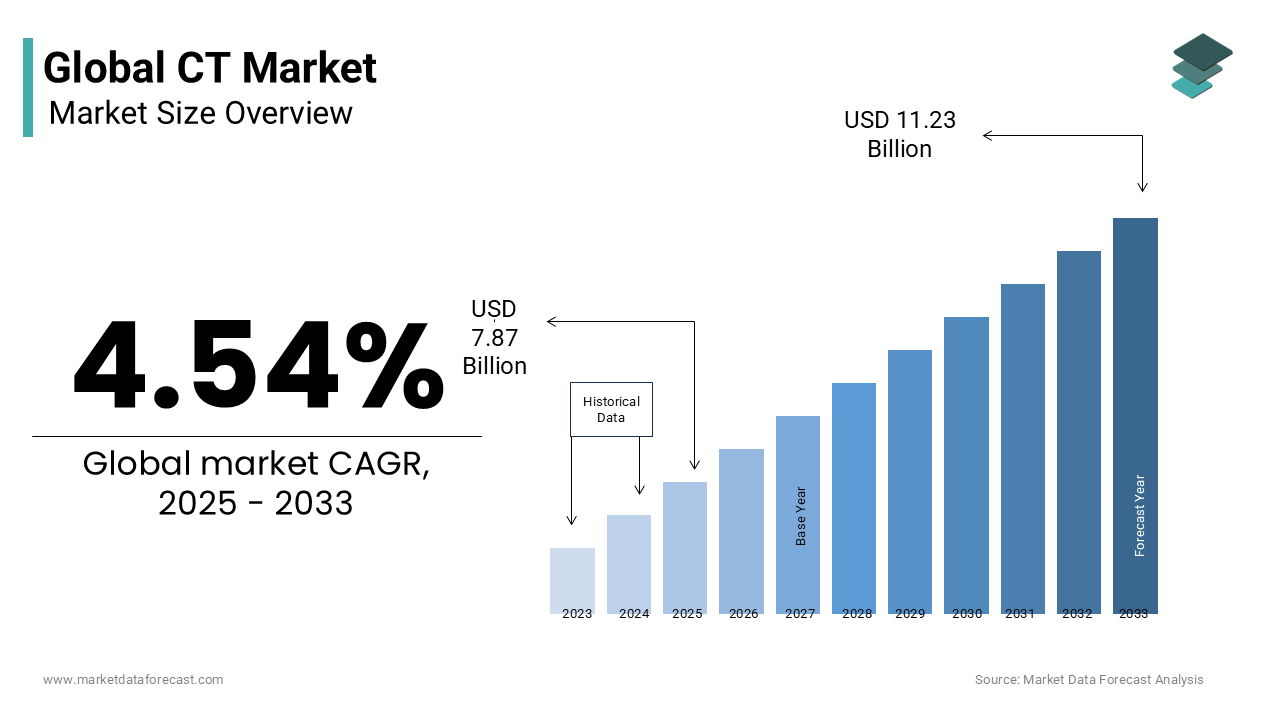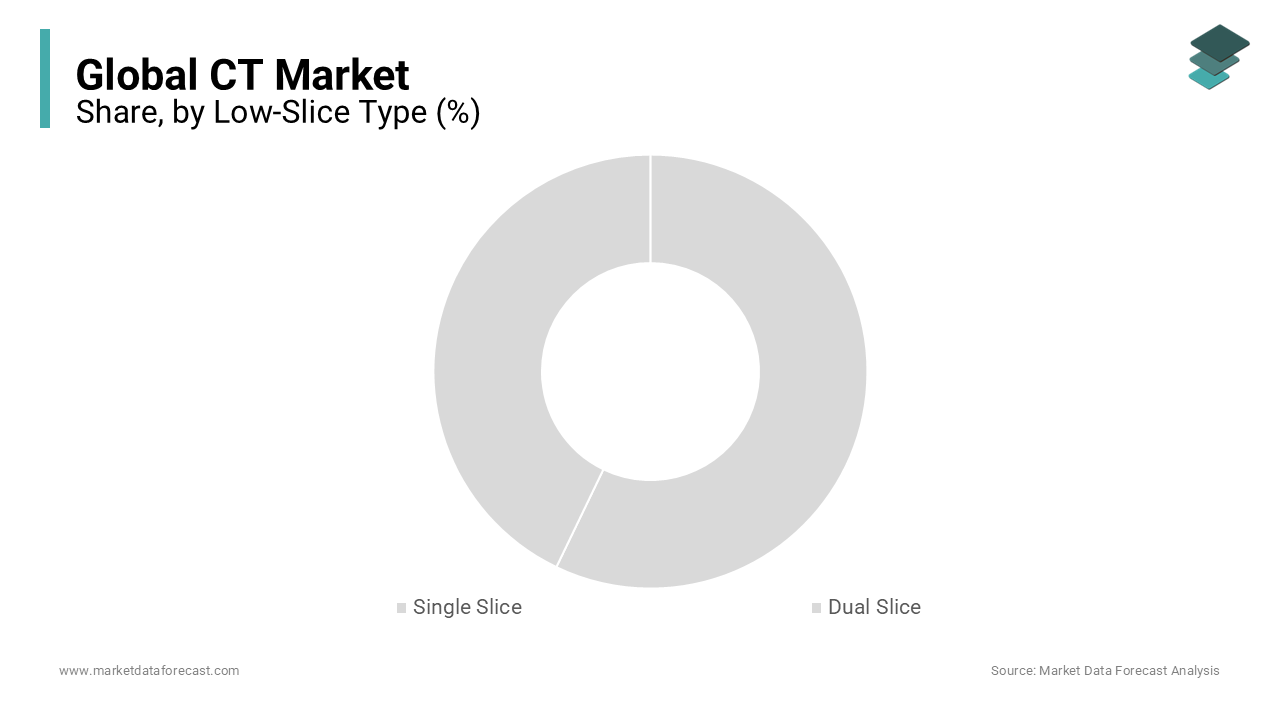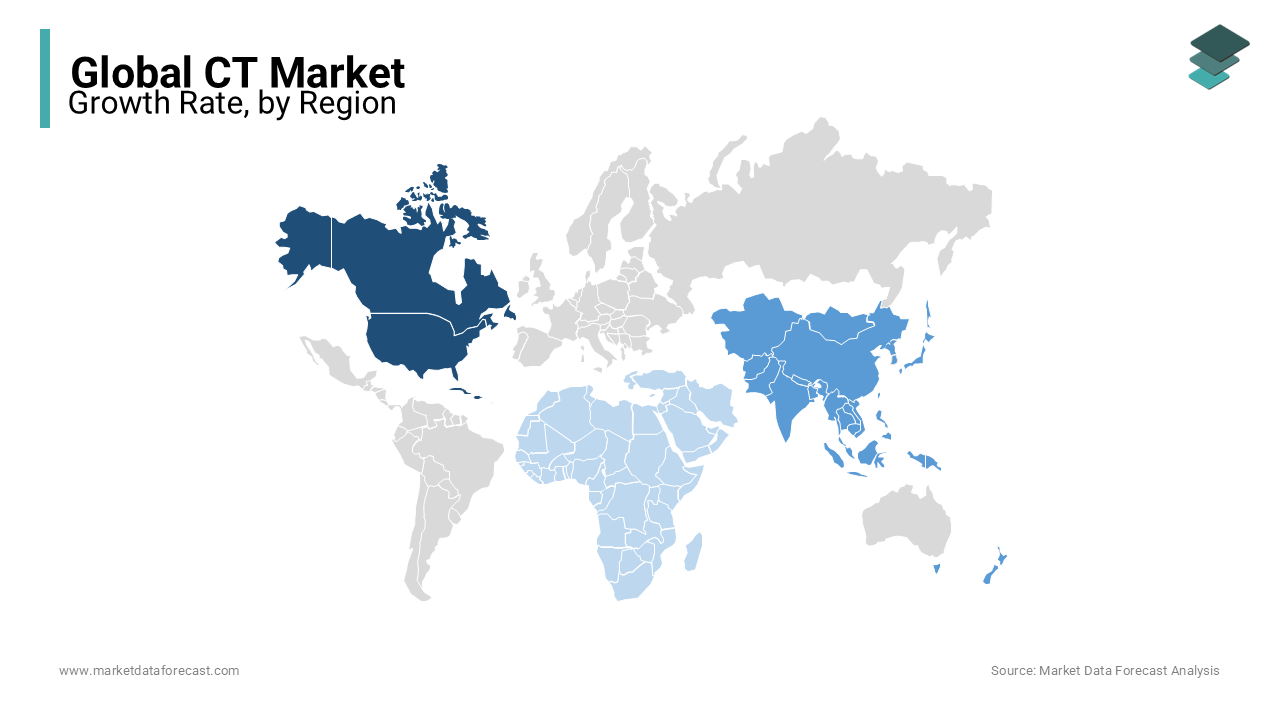Global CT Market Size, Share, Trends & Growth Forecast Report – Segmented By Low-slice Type (Single Slice and Dual Slice), Slice Type (6 Slice, 10 Slice, 16 Slice and 32 Slice), High-slice Type (40 Slice, 64 Slice, Open Versions and Cardiac CT), End-Users and Region (North America, Europe, Asia Pacific, Latin America, and Middle East & Africa) - Industry Analysis From 2025 to 2033
Global CT Market Size
The global CT market size was valued at USD 7.53 billion in 2024. The global CT market is estimated to be worth USD 7.87 billion in 2025. It is estimated to reach USD 11.23 billion by 2033, growing at a CAGR of 4.54% from 2025 to 2033.

CT scan is a medical image technique. CT scans are well-known for taking detailed and cross-sectional images of the internal organs and structures of the body using X-ray and advanced computer algorithms. During the CT scan, a computer later processes several X-ray images of the body from various angles, developing a detailed 3D image of the body part being scanned. CT scans diagnose various diseases, especially those that impact bones, soft tissues, and blood vessels. CT scans are high in diagnosing diseases such as cancer, heart disease, stroke, and traumatic injuries. In recent years, computed tomography has experienced several technological developments. Modern CT scanners are pretty much more advanced than traditional CT scanners and modern CT scanners are equipped with advanced algorithms and software. As a result, they can produce images of higher quality and give less radiation exposure to the patients.
MARKET DRIVERS
The growing aging population worldwide is expected to boost the CT market growth.
The incidence of diseases cancer, CVDs and neurological disorders stay high among people who are aged. The usage of CT scanners is usually high in the treatment procedures of such diseases. The usage and demand for CT scanners and scanning procedures increase with the growing number of aged people suffering from these diseases. According to the data published by the World Health Organization (WHO), an estimated 1.4 billion people are expected to be aged 60 and above by 2030, which is also considered as 1 in every 6 people. As per the data given by the Population Reference Bureau (PRB), the number of people aged above 65 years was 52 million in 2018 and this number is expected to grow to 95 million by 2060.
The growing patient population suffering from chronic diseases is anticipated to propel the growth rate of the CT market. CT scanning is the commonly used medical imaging technique to diagnose and treat chronic diseases such as cancer, heart disease, and neurological disorders. The population suffering from chronic diseases has grown gradually worldwide over the last several years, propelling the demand for CT imaging. According to the data published by the World Health Organization (WHO), an estimated 41 million people died of chronic diseases in 2019. According to the Centers for Disease Control and Prevention (CDC), 6 in 10 adults in the United States have at least 1 chronic disease and 4 in 10 adults have multiple chronic diseases. Therefore, people suffering from chronic diseases frequently use CT imaging for diagnosis and monitoring. In recent years, CT has gained popularity as one of the effective diagnostic tools due to the technological advancements that made the CT technology imaging process faster, more accurate, and less invasive.
The growing demand for bedside imaging, home healthcare, and the rising usage of CT scan to evaluate the efficiency of post-interventional medical procedures, medical implants, and anatomical confirmation further propels the global CT market growth. In addition, the rising pervasiveness of diseases such as cancer and orthopedic, cardiovascular, and dental disorders are also forecasted to accelerate the growth rate of the global CT market. Moreover, a perpetual increase in medical implant operations due to lifestyles and a growing senior population may increase the demand. The high success rate of using CT scans for many procedures in various applications drives the global CT scan market. It is used in Oncology for detecting and assessing cancer and tumors. It also helps in real-time monitoring of the success of cancer treatment, which has proven to be a valuable tool in this field. In Neurology, Alzheimer's disease, Parkinson's disease, dementia, and other movement disorders are detected by providing precise location of epilepsy surgery. It checks the exact location of live and dead heart tissue and predicts the success rate of angioplasty or bypass surgery, finding a profitable use in Cardiology.
MARKET RESTRAINTS
Poor awareness among people regarding the advantages of CT technology in underdeveloped and developing countries is hampering the overall growth rate of the CT market.
High costs associated with CT scanners are difficult for small and medium-sized healthcare facilities to afford, which is inhibiting the CT market growth. Furthermore, unfavorable reimbursement policies for CT scans in some countries negatively impact the CT market growth. Furthermore, health risks associated with using CT scans such as the risk of cancer and other health issues are expected to hinder the market growth. In addition, the scarcity of skilled professionals who can handle the operations of CT scanners is predicted to limit the market’s growth rate.
REPORT COVERAGE
|
REPORT METRIC |
DETAILS |
|
Market Size Available |
2024 to 2033 |
|
Base Year |
2024 |
|
Forecast Period |
2025 to 2033 |
|
Segments Covered |
By Slice Type, Low-slice Type, High-slice Type, End Users, and Region |
|
Various Analyses Covered |
Global, Regional & Country Level Analysis, Segment-Level Analysis; DROC, PESTLE Analysis, Porter's Five Forces Analysis, Competitive Landscape, Analyst Overview of Investment Opportunities |
|
Regions Covered |
North America, Europe, APAC, Latin America, Middle East & Africa |
|
Market Leader Profiled |
G.E. Healthcare, Hitachi Medical Corporation, Hitachi Medical Systems America, Inc., NeuroLogica Corporation, Neusoft Medical Systems Co. Ltd., Philips Healthcare, Shenzhen Anke High-Tech Co., Siemens Healthcare, and Toshiba Medical Systems Corporation |
SEGMENTAL ANALYSIS
Global CT Market By Low-slice Type
Based on the low-slice type, the single-slice segment is predicted to be the leader in the global CT market during the forecast period. The rise in patients suffering from chronic and infectious diseases and increasing awareness of using advanced devices are increasing the market's growth. A single-slice CT scan involves only one X-ray source and a single detector. It is widely used because of its data acquisition through 180-degree rotation, involving the movement of both tubes and the detector across the scan plane, through which a series of transmission measurements are obtained.

The dual-slice or multi-slice segment is anticipated to dominate the market, primarily due to its reduced amount of time and radiation exposure to the patient, depending on either design of the scanner or the way of application of the scanner.
Global CT Market By Slice Type
The 6-slice CT scan is highly expected to share a significant share in the market due to its compact air-cooled gantry and an efficient full-body CT scanner, ensuring a productivity rise and ease of use.
The 16-slice CT scanner would also be dominating the market since the body images are taken much faster than other scanners by capturing multiple images in a much lesser time, a few seconds, increasing patient comfort.
Global CT Market By High-slice Type
Based on the high-slice type, the 40-slice category in the high-slice type leads the global CT market with the most dominating share due to the growing prevalence of medical implants, the adoption of sedentary lifestyles, and changes in food habits.
Sixty-four slice scanners are foreseen to dominate this segment since it provides a high-resolution of all the anatomical images at every rotation in a reduced time, under 15 seconds, without increasing X-ray projections overlapping.
Global CT Market By End-Users
- Hospitals and Clinics
- Imaging Centers
- Others
Based on the end-users, the hospitals and clinics end-user segment led the global CT market in 2023. Increasing support from the government through investments in the construction activities of healthcare centers and hospitals and the growing demand for quality diagnostic procedures are accelerating the growth of this segment.
REGIONAL ANALYSIS

The North American CT market is estimated to witness a leading share of the global market during the forecast period due to the rapid adoption of advanced technology and various devices in favor of patient safety. With modern techniques, the devices allow the patient to have lower exposure to higher radiation, which promotes fewer side effects, enhancing the market's growth in this region. In addition, the growing disposable income and increasing healthcare expenditure are promoting the growth of the CT market in North America. During the forecast period, the U.S. is expected to hold the major share of the North American market, followed by Canada.
The Asia Pacific CT market is anticipated to register the fastest CAGR in the global market during the forecast period owing to the increasing aging population and risks from colon cancer. On the other hand, developing countries such as India, Japan, and China are expected to register most of the share in the APAC market during the forecast period.
On the other hand, the Europe CT market is predicted to grow at a healthy CAGR during the forecast period and offer lucrative growth possibilities to the market participants. Increasing healthcare expenditure and effective treatment procedures at any cost boost this region's growth rate. As a result, the U.K. and Germany are predicted to lead the European market.
The CT market in Latin America is expected to be worth USD 1 billion by 2029. The growing patient population suffering from chronic diseases, the increasing aging population and the rapid adoption of technological developments in CT imaging systems are anticipated to drive the CT market growth in Latin America. During the forecast period, countries such as Brazil, Mexico, and Argentina are predicted to occupy a major share of the Latin American market.
The MEA CT market is anticipated to showcase a CAGR of 4.76% from 2024 to 2029.
KEY MARKET PLAYERS
Companies leading the Global CT market profiled in the report are G.E. Healthcare, Hitachi Medical Corporation, Hitachi Medical Systems America, Inc., NeuroLogica Corporation, Neusoft Medical Systems Co. Ltd., Philips Healthcare, Shenzhen Anke High-Tech Co., Siemens Healthcare, and Toshiba Medical Systems Corporation.
RECENT MARKET DEVELOPMENTS
- In November 2022, Sunnybrook Health Sciences Center and Bayer Inc. launched an innovative injector for computed tomography, MEDRAD Centargo CT Injector System, with the ability to get the job done quickly and with less hassle.
- In November 2020, GE Healthcare acquired Prismatic Sensors AB, a Sweden-based developer of CT images. It is one of the next-generation photons-counting technologies in Sweden and will help the GE healthcare company expand clinical research on CT scanners.
- In July 2020, Philips listed COVID' imaging cabins' for safer X-ray and CT scan delivery during the pandemic. These are the new industrial shipping containers, which are named COVID cabins.
- In September 2020, Siemens Healthineers developed imaging capabilities with attention to patient experience. As a result, Florida's Orlando Health Orlando Regional Medical Center has become the first healthcare institution in the United States to install SOMATOM X.cite, a premium single-source CT Scanner.
- In March 2016, Hitachi Medical Corporation and Redlen Technologies Inc. announced to development of the Next Generation Medical Photon Counting CT system. Under this agreement, the companies are to develop a direct conversion semiconductor x-ray detector module, which is required for new photon-counting computed tomography systems (PCCT).
DETAILED SEGMENTATION OF THE GLOBAL CT MARKET INCLUDED IN THIS REPORT
This research report on the global CT market has been segmented and sub-segmented into the following categories.
By Low-slice Type
- Single Slice
- Dual Slice
By Slice Type
- 6 Slice
- 10 Slice
- 16 Slice
- 32 Slice
By High-slice Type
- 40 Slice
- 64 Slice
- Open Versions
- Cardiac CT
By End-Users
- Hospitals and Clinics
- Imaging Centers
- Others
By Region
- North America
- Europe
- Asia Pacific
- Latin America
- The Middle East and Africa
Frequently Asked Questions
How much is the global CT market going to be worth by 2032?
As per our research report, the global CT market size is projected to value at USD 10.74 billion by 2032.
Does this report include the impact of COVID-19 on the CT market?
Yes, we have studied and included the COVID-19 impact on the global CT market in this report.
Which region led the global CT market in 2023?
Geographically, the North American regional market accounted for the largest share of the global CT market in 2023.
Which are the major players operating in the CT market?
GE Healthcare, Hitachi Medical Corporation, Hitachi Medical Systems America, Inc., NeuroLogica Corporation, Neusoft Medical Systems Co. Ltd., Philips Healthcare, Shenzhen Anke High-Tech Co., Siemens Healthcare, and Toshiba Medical Systems Corporation are some of the notable companies operating in the global CT market.
Related Reports
Access the study in MULTIPLE FORMATS
Purchase options starting from $ 2500
Didn’t find what you’re looking for?
TALK TO OUR ANALYST TEAM
Need something within your budget?
NO WORRIES! WE GOT YOU COVERED!
Call us on: +1 888 702 9696 (U.S Toll Free)
Write to us: [email protected]
